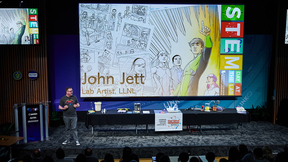Physicist's laser research wins SPIE honor
 (Download Image)
Chris Barty stands near the ARC petawatt laser system at the National Ignition Facility. Barty was honored with the SPIE Harold E. Edgerton Award for his work in ultrafast laser research. Photo by Clayton Dahlen/LLNL.
(Download Image)
Chris Barty stands near the ARC petawatt laser system at the National Ignition Facility. Barty was honored with the SPIE Harold E. Edgerton Award for his work in ultrafast laser research. Photo by Clayton Dahlen/LLNL.
Christopher Barty, the chief technology officer for the National Ignition Facility and Photon Science Directorate, has won the 2016 SPIE Harold E. Edgerton Award for his work on ultrafast lasers and laser-based X-ray and gamma ray science.
"I feel very honored to have won this award and to now be somehow associated with the legacy of ‘Doc’ Edgerton," Barty said.
Edgerton was an MIT professor known for his pioneering efforts to photographically capture fast physical events. In the 1950s, he produced the first photos of the initial phases of nuclear explosions. To do this, he created a 10-foot long-lens and the special triggering mechanisms so that the photo could be recorded at a "safe" distance.
While this work was National Nuclear Security Administration-relevant, Edgerton is better known for his work in stop motion photography. His work is found in the popular press, e.g. a milk droplet hitting a solid surface or a bullet passing through an apple or a playing card.
The Harold E. Edgerton Award is presented annually for outstanding contributions to optical or photonic techniques in the application and understanding of high speed physical phenomena. The development of new technologies and the new application of existing technologies are considered in the determination of the award. Barty is specifically cited for "his efforts in the development of foundational techniques that have enabled ultrafast, intense lasers and for pioneering contributions to time-resolved, X-ray and gamma-ray science conducted with such lasers." He will receive his award at the summer meeting of the Society of Photo-optical Instrumentation Engineers (SPIE) in San Diego.
At LLNL, Barty has led R&D efforts to develop the kilojoule-class ultrahigh intensity lasers, which will soon be used to probe nuclear fusion at the National Ignition Facility, and has invented and developed new mono-energetic gamma-ray technologies that enable isotope-specific material detection, assay and imaging. Prior to LLNL, Barty and his teams created record-setting, ultrafast, high-intensity laser systems and used these for numerous groundbreaking experiments including; excitation of novel X-ray lasers, direct observation of non-thermal melting in semiconductor systems and reduced-dose, time-gated medical imaging, and more.
"My work, by its nature has always required a team effort and over the years has involved numerous talented researchers, staff and students," Barty said. "Without the inspiration, efforts and camaraderie of these individuals, I could not have won this award."
He earned bachelor degrees with honors in chemistry, physics and chemical engineering from North Carolina State University and a master’s and Ph.D. in applied physics from Stanford University.
Barty is a fellow of the Optical Society of America (OSA), the Society of Photo-optical Instrumentation Engineers (SPIE), the American Physical Society (APS), a senior member of the Institute of Electrical and Electronics Engineers (IEEE) and co-chair of the International Committee on Ultrahigh Intensity Lasers (ICUIL).
Prior to coming to LLNL in 2000, Barty served as the director of advanced technology at Positive Light Inc. and chief executive officer of Positive Research Inc. as well as director of ultrafast science in the Department of Applied Mechanics & Engineering Science at the University of California, San Diego and as a member of the faculty for the departments of applied physics and electrical engineering at Stanford University.
Contact
 Anne M. Stark
Anne M. Stark
[email protected]
(925) 422-9799
Related Links
National Ignition Facility & Photon ScienceSPIE
Haraold E. Edgerton Award
Tags
Lasers and Optical S&TLasers
National Ignition Facility and Photon Science
Featured Articles







